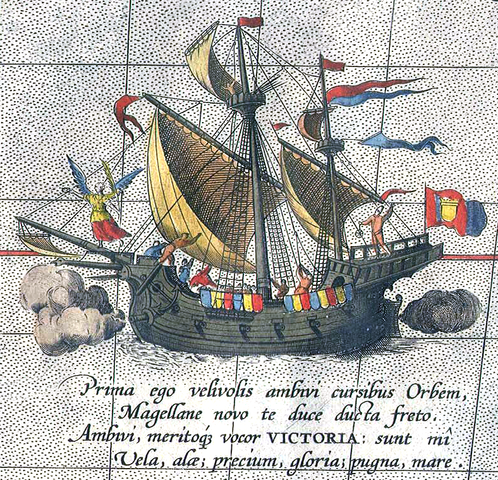*Image Credit: Wikipedia Launched in 1519, the Spanish expedition led by Ferdinand Magellan set out to be the first in history to make it all the way around the world. Of the five ships that left, only one, the Victoria would make it back to Spain, docking in Sanlucar de Barrameda on September 6th, 1522. Having covered more than 42,000 miles of ocean — more than half of it completely unfamiliar — the leaking boat only managed to return thanks to the crew working day and night to pump water from within the hull. Twenty-five years after Christopher Columbus had set foot in the New World for Spain, Magellan and two associates presented the idea of western route to the “Spice Islands” to King Charles I in 1517. With a foothold in South America and a clearer conception of the size of the planet, Magellan believed his expedition could sail around the continent and move west from modern Chile in order to discover a route which would bring untold wealth to the Spanish Crown. Excited by the possibility, Charles agreed and guaranteed the men five ships — the Trinidad, San Antonio, Concepcion, Santiago and Victoria. After building a crew of 270, the voyage departed on August 10, 1519 from Seville with Magellan at the helm of the Trinidad. Three months later, the group anchored in Rio de Janeiro, Brazil to load up on supplies. As 1520 dawned, Magellan led his expedition down the eastern coast of the continent, establishing settlements in the name of Charles I. Late in the year, the ships reached Tierra del Fuego, the southernmost point of South America. Now through to the South Pacific, Magellan guided his crew northwest. On March 17, 1521, the expedition reached the Philippines. Attacked by native tribes upon landing at Mactan, Magellan and 30 crewmen were killed in fierce fighting. The remaining crew, just enough to fill up the Trinidad and Victoria, setting sail in May and landing in Borneo in mid-June. The following November, the 115 remaining crew reached the Spice Islands (Maluku), just as Magellan had intended. Weary and ready to return to Europe, the remaining two ships split up. Victoria left on December 21, 1521 with Juan Sebastian Elcano in charge and Trinidad behind awaiting repairs. (The latter would later be captured by the Portuguese days after attempting to cross the Indian Ocean.) On May 6, 1522, the ship turned north up the west coast of Africa with only rice to eat, causing 20 sailors to die of starvation. Before completing the voyage on September 6, Elcano had forced 13 others to disembark in order to save the 26-ton load of cinnamon and cloves. The 18 men remaining aboard, gaunt and fatigued, presented themselves to the court of Charles I days later. When the Victoria and the rest of the ships left, Magellan had only aimed to find a to-and-fro route to the Spice Islands. His desire was simply to go the other direction in order to avoid rival traders. Completing the full trip around the world only occurred because Elcano, relatively unknown to history, decided to strike to the west and risk being taken by the Portuguese fleet.
September 6, 1522 CE – Victoria Sails into Port in Spain, Arriving as the First Ship to Circumnavigate the World
*Image Credit: Wikipedia Launched in 1519, the Spanish expedition led by Ferdinand Magellan set out to be the first in history to make it all the way around the world.…
647
